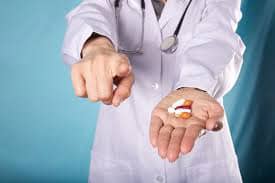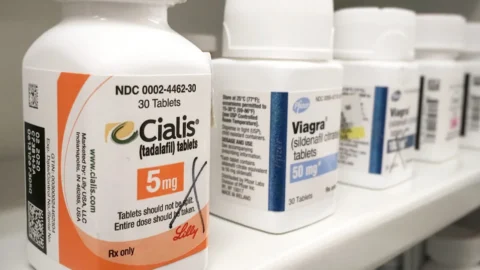The prevalence of testosterone deficiency (aka hypogonadism or Late Onset Hypogonadism), defined as total testosterone (TT) at or below 300 ng/dl is close to 40% in men aged 45 years and older presenting to primary care offices in the US.1 Year 2006 is was estimated that more than 13.8 million men over 45 years of age visiting a primary care doctor in the United States have symptomatic androgen deficiency.1
A large international web survey using the Aging Males’ Symptoms (AMS) questionnaire showed the prevalence of symptomatic testosterone deficiency to be 80% in men aged 16–89 (mean 52 years).2 It is notable that in the survey 40% of respondent were at younger ages when ‘Late Onset Hypogonadism’ is generally not believed to be occurring.2 The surprisingly high prevalence of raised scores indicative of testosterone deficiency in the younger age groups may be due to the increasing prevalence of conditions in these age groups known to reduce testosterone levels, such as obesity 3-7 and chronic work stress. 8-10 Stress-induced cortisol elevation, by increasing SHBG, lowers the free active fraction of testosterone and thereby reduces its action.11
This large and rising prevalence of testosterone deficiency is gaining recognition among doctors and patients alike. However, while testosterone replacement therapy (TRT) confers great benefits to men with sup-optimal testosterone levels, it also comes with some side-effects which are especially relevant for men who wish to have a family…Many testosterone users and even clinicians 12 are unaware that testosterone supplementation suppresses the hypothalamic-pituitary-gonadal (HPG) axis and may result in infertility…
Does TRT really reduce sperm count and increase the risk of infertility?
It might…. Testosterone supplementation (in some cases even in replacement doses, see below) interferes with spermatogenesis (sperm production) by suppressing the HPG axis via negative feedback. This inhibits GnRH (gonadotropin releasing hormone), which in turn inhibits the secretion of FSH (follicle-stimulating hormone) an LH (luteinizing hormone). Both intra-testicular testosterone and FSH are required for quantitatively normal spermatogenesis.13-15 Suppression of gonadotropins (LH and FSH) deprives the testes of the signals required for both testosterone production and spermatogenesis, leading to markedly suppressed sperm counts in many men.16 TRT has been reported to cause azoospermia (absence of motile (and hence viable) sperm in the semen) in 40% of patients. 17
When supplementing testosterone, despite normal-to-high blood levels of testosterone, intra-testicular testosterone levels necessary to maintain spermatogenesis may be too low. Testicular atrophy is a sign that the testes are deprived of LH and FSH, and that endogenous testosterone production is impaired.
What about the functional capacity (motility) of residual spermatozoa?
In healthy men, suppression of spermatogenesis to moderate oligozoospermia (below 10 million per /mL ejaculate, in normal men sperm concentrations exceed 15 million/mL ejaculate 16) with T enanthate injections 200 mg/wk for up to 10 weeks, was not associated with impaired sperm function of the residual spermatozoa.18 However, this finding does not exclude the possibility that disorders of sperm function might occur when spermatogenesis is suppressed further to very severe oligozoospermia (below 1 million/mL), commonly observed in hormonal male contraceptive clinical trials.18
Is the loss of sperm count reversible?
Studies on male hormonal contraception using testosterone give insights into the effect and time to recovery of spermatogenesis with cessation of testosterone supplementation. An analysis of 30 studies from 1990-2005, in which sperm output was monitored every month until recovery, was conducted in order to investigate rate, extent, and predictors of spermatogenic recovery after male hormonal contraception.19 Included in the study were 1,549 healthy eugonadal men aged 18-51 years, who underwent (>1200 man-years of) treatment with testosterone or testosterone -progestagen regimens and >700 man-years of post-treatment recovery. The primary outcome was the time for the sperm concentration to recover to a threshold of 20 million/mL ejaculate, which is an indicator of fertility.
As shown in table 1, the typical probability of recovery to 20 million/mL was 67% within 6 months, 90% within 12 months, 96% within 16 months, and 100% within 24 months. These recovery times are for endogenous (non-assisted) recovery.
Table 1: Probability of sperm recovery to various thresholds (click image to see the complete table).

Higher rates of recovery are seen with shorter treatment duration, shorter-acting testosterone preparations, higher sperm concentrations at baseline, faster suppression of spermatogenesis, and lower blood LH levels at baseline. This large analysis of 30 studies shows full reversibility within a predictable time course, and that various predictors affect the rate, but not the extent, of recovery.19 However, it should be cautioned that return of spermatogenesis may be prolonged for some number of men, which may be of concern for those who still are interested in paternity.
How to speed up recovery of spermatogenesis after TRT or reduce the risk of infertility with TRT?
For those hypogonadal men who desire to protect their future fertility in the near future, testosterone supplementation should be done in a low dose, or temporarily discouraged. As demonstrated in the contraceptive trials, while cessation of testosterone therapy often restores baseline testosterone levels, it might take up to 2 years (if non-assisted). An alternative to TRT is to use HCG or Clomid (clomiphene citrate) to increase endogenous testosterone production. HCG and clomid can also be used after a TRT cycle to speed up recovery of natural (endogenous) testosterone production and spermatogenesis.
Coming next…
In part 2 I will outline notable studies that have investigated HCG, HCG+T and clomid for the purpose of increasing endogenous testosterone production, or speeding up recovery of endogenous testosterone and sperm production after a TRT cycle. Stay tuned…
References:
1. Mulligan T, Frick MF, Zuraw QC, et al. Prevalence of hypogonadism in males aged at least 45 years: the HIM study. International journal of clinical practice. 2006;60(7):762-769.
2. Trinick TR, Feneley MR, Welford H, et al. International web survey shows high prevalence of symptomatic testosterone deficiency in men. The aging male : the official journal of the International Society for the Study of the Aging Male. 2011;14(1):10-15.
3. Ng Tang Fui M, Hoermann R, Cheung AS, et al. Obesity and age as dominant correlates of low testosterone in men irrespective of diabetes status. Andrology. 2013;1(6):906-912.
4. Tang Fui MN, Dupuis P, Grossmann M. Lowered testosterone in male obesity: Mechanisms, morbidity and management. Asian journal of andrology. 2013.
5. Saboor Aftab SA, Kumar S, Barber TM. The role of obesity and type 2 diabetes mellitus in the development of male obesity-associated secondary hypogonadism. Clinical endocrinology. 2013;78(3):330-337.
6. Saad F. Androgen therapy in men with testosterone deficiency: can testosterone reduce the risk of cardiovascular disease? Diabetes/metabolism research and reviews. 2012;28 Suppl 2:52-59.
7. Saad F, Gooren LJ. The role of testosterone in the etiology and treatment of obesity, the metabolic syndrome, and diabetes mellitus type 2. Journal of obesity. 2011;2011.
8. Schoofs D, Wolf OT. Are salivary gonadal steroid concentrations influenced by acute psychosocial stress? A study using the Trier Social Stress Test (TSST). International journal of psychophysiology : official journal of the International Organization of Psychophysiology. 2011;80(1):36-43.
9. Lennartsson AK, Kushnir MM, Bergquist J, et al. Sex steroid levels temporarily increase in response to acute psychosocial stress in healthy men and women. International journal of psychophysiology : official journal of the International Organization of Psychophysiology. 2012;84(3):246-253.
10. Maestripieri D, Baran NM, Sapienza P, et al. Between- and within-sex variation in hormonal responses to psychological stress in a large sample of college students. Stress. 2010;13(5):413-424.
11. Carruthers M. The paradox dividing testosterone deficiency symptoms and androgen assays: a closer look at the cellular and molecular mechanisms of androgen action. The journal of sexual medicine. 2008;5(4):998-1012.
12. Ko EY, Siddiqi K, Brannigan RE, et al. Empirical medical therapy for idiopathic male infertility: a survey of the American Urological Association. The Journal of urology. 2012;187(3):973-978.
13. McLachlan RI, O’Donnell L, Meachem SJ, et al. Hormonal regulation of spermatogenesis in primates and man: insights for development of the male hormonal contraceptive. Journal of andrology. 2002;23(2):149-162.
14. Depenbusch M, von Eckardstein S, Simoni M, et al. Maintenance of spermatogenesis in hypogonadotropic hypogonadal men with human chorionic gonadotropin alone. European journal of endocrinology / European Federation of Endocrine Societies. 2002;147(5):617-624.
15. Madhukar D, Rajender S. Hormonal treatment of male infertility: promises and pitfalls. Journal of andrology. 2009;30(2):95-112.
16. Roth MY, Amory JK. Pharmacologic development of male hormonal contraceptive agents. Clinical pharmacology and therapeutics. 2011;89(1):133-136.
17. Hsieh TC, Pastuszak AW, Hwang K, et al. Concomitant intramuscular human chorionic gonadotropin preserves spermatogenesis in men undergoing testosterone replacement therapy. The Journal of urology. 2013;189(2):647-650.
18. Wang C, Leung A, Superlano L, et al. Oligozoospermia induced by exogenous testosterone is associated with normal functioning residual spermatozoa. Fertility and sterility. 1997;68(1):149-153.
19. Liu PY, Swerdloff RS, Christenson PD, et al. Rate, extent, and modifiers of spermatogenic recovery after hormonal male contraception: an integrated analysis. Lancet. 2006;367(9520):1412-1420.







Great info 🙂 Do you know something about LH receptors in the brain ? I am asking this, because I read that some trt users are feeling better and have better libido when combine testosterone and hcg on therapy than testosterone alone.
I only found this study http://www.ncbi.nlm.nih.gov/pubmed/8477671
And, if man is on this combo (test+hcg) will he remain 100% fertile, because he’ll be producing endogenus testosterone and simulating LH ?
I will cover that in part 2… 🙂
can’t wait 😛
Hi Monica,
I understand the point of the article and there is a significant amount of outstanding information here on TRT and fertitlity.
Unfortunateky you start your article with a statement that undermines the bad behavior that both of us have been working against for years. While it’s true that the low information physician will diagnose hypogonadism by treating a lab form and determining if a testostosterone value is above or below 300, we know that this is an asinine practice that will miss many men that are testosterone deficient. Repeating that here where men come for reliable information only serves to reinforce the scientific predjudice associated with this practice.
Jim, I’m unclear how whet she wrote “undermines the bad behavior that both of us have been working against for years.”
Can you clarify a bit on that?
Hi Will,
Sure. I was referring to her opening statement that T deficiency is defined as a level at or below 300.
Jim, I am just citing a study that happened to define TD as a TT level at or below 300 ng/dl. This doesn’t mean that there is a specific threshold for TD that applies to every man across the board.
Hi Monica, yes I understnd that you are citing a study – one that neither of us believe has any efficacy. It took me 2 minutes to find your article “How is Low T Diagnosed” where you state as the first critical problem with diagnosing T deficiency is:
“1. The assumption that there is a specific testosterone level threshold below which the symptoms appear, and that this threshold is the same for everybody.”
I speak to several men per month that see their uninformed doc with symptoms of T deficiency that are turned away from therapy because they are just above the low end of the referance range. So the guy who is deficient with a level of 350 that comes here and reads your article is going to have the ding dong doc’s low information opinion reinforced.
Why even mention this?
I’m interested to know your thoughts on the presence of testosterone feeding prostate cancer and if injections of test cypionate vs jells and creams make a difference. From early 2012 to Aug 2012, I was getting 200 mg test cyp injections via the VA for low test. In late Aug, I was diagnosed with prostate cancer and given a anti androgen shot that took my test from 836 to 22 ng. Cancer has been gone for some time and the past 5 months my doctor has given me Testofen. He can’t understand why my test is only 325. I’d like to go back to shots. What do you think?
The effect of T on the prostate is controversial; I don’t know your medical history and I am not a doctor, so I cannot advice you on this. You might want to check out Dr. Morgentaler’s opinion on this:
http://www.menshealthboston.com/inthenews
Scroll down and at the bottom of the page are two videos covering this issue.
Thanks for the speedy replay and the information Monica.
Hi Eldon,
Elevated levels of T generally are thought to decrease the incidence of prostate cancer. However there is some evidence that those that have had prostate cancer and their T levels are reduced to castration levels (essentially zero) and then increased have a high incidence of relapse.
Monica’s recommendation is absolutely correct. I wouldn’t touch this with a recommendation either. See her reference with for Dr. M.
Also topical formulations generally increase conversion to DHT compared to injectable formulations as the enzyme that catalyzes this reaction (5 alpha reductase) is found in higher concentrations is the skin.
Test cypionate has a half life of about 6-8 days, not 12 as indicated in the literature. How much time passed between your last injection and blood work? If it was 7 days that would be odd.
Does today’s news from the Nevada State Athletic Commission (http://bleacherreport.com/tb/dcxCF?utm_source=newsletter&utm_medium=newsletter&utm_campaign=mma) help or hinder the average 45+ guy who may have symptoms of low T? In the linked article, Dr. Timothy Trainor, a consulting physician for the Nevada State Athletic Commission has estimated that less than one-percent of people are affected by hypogonadism which is somewhat different to the figures quoted in this article. Who is right and what’s your opinion of this decision by the Nevada State Athletic Commission?
Gary,
This article is written in the context of professional sports and performance enhancing drugs. Not really applicable here. However his opinion of hypogonadism is not backed up in the literature. He is just another in a long line of low information physicians discussing an issue they don’t understand.
His opinion is likely based on lab reference range data that is not indicative of health. Rather it’s just a statistical analysis. For that matter, using this data should result in hypogomadism showing up in about 2.5% of the population. He can’t even get the low information doc talking points right.
That’s right; use of TRT in athletes (even clinically hypogonadal) brings up several issues not pertinent to the vast majority of the population.
Hi Monica, did you ever do a part 2 to this article? Very curious how to speed up recovery of spermatogenesis after a 6 months of low dose TRT. I have HCG and debating taking it to speed things up.
Daniel